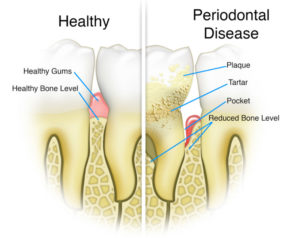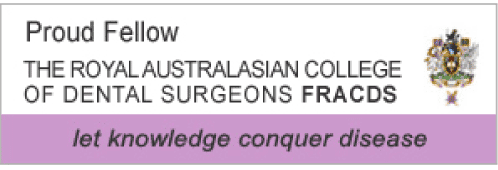 Do your gums bleed when you brush or floss your teeth?
Do your gums bleed when you brush or floss your teeth?
Do your teeth feel sensitive when you eat ice cream or have a cold drink?
If you’re noticing blood in the basin after you brush your teeth, have sensitive teeth or feel like a tooth is loose, you may have gum disease.
Gum disease is also known as gum inflammation, gingivitis or periodontal disease. It can be caused by:
- Plaque and tartar,
- Smoking,
- Stress,
- Genetics and
- Systemic conditions, such as diabetes.
Common symptoms of periodontal gum disease include:
- Redness, swelling and bleeding gums
- Gum recession
- Sensitive teeth
- Bad breath or a bad taste in the mouth, and
- Loose or separating teeth
What should you do if your dentist tells you that you’ve got early signs of gum disease?
It’s important to take this information seriously. Recent studies have shown that there are links between gum disease and other systemic diseases such as heart disease, diabetes and adverse pregnancy complications.
How does gum disease progress?
Your gums and the supporting bone hold your teeth in position and protect the roots. Healthy, pink and firm gums are an essential foundation to a disease-free mouth.
If your gums bleed when you brush or floss, it can be an early sign of periodontal disease. It can be easy to ignore this but left untreated, your gums will start to pull away from the teeth and create ‘pockets’ between your teeth and gums.
These periodontal pockets collect plaque and tartar, and hold bacteria and toxins. It’s these bacterial toxins that irritate your gums and cause inflammation and bleeding.
We examine your gum health thoroughly as part of routine dental check up https://mosmanvillagedentistry.com.au/services/for-dental-health/dental-check-up-hygiene/ by using a periodontal probe (similar to a ruler) to screen your overall gum health and measure the depths of any periodontal pockets.
In healthy gums, the pocket depths range between 1–3mm. In areas affected with periodontal disease or periodontitis, the pocket depths are 4mm or greater. These deeper pockets indicate gum detachment from the teeth and loss of supporting bone.
How do we treat periodontal disease?
We treat periodontal disease by removing all of the plaque and tartar in the periodontal pockets. This process is called scaling and root planing. Ultrasonic scalers (using high frequency vibrations) are used to break up and loosen large deposits of tartar embedded on the surface of the roots.
After the tartar is removed, special hand instruments are then used to root plane your exposed root surfaces. The root planing process aims to create a clean and smooth surface, as there’s less chance of plaque and tartar building up on a smooth surface. This smooth, clean surface of roots will make it easier for you to maintain healthy gums.
After the tartar and bacteria are removed from the periodontal pockets, your gums will heal and tighten around your teeth. Once the gums become healthy again, there should be no bleeding or swelling. Some people even notice previously loose teeth become firmer again.
It’s important to note that if your oral hygiene is not adequate, reinfection of your gums can occur again. If deep pockets are still there after the initial scale and root planing, and your gums continue to bleed, you may need to be referred to a specialist Periodontist for a surgical approach to gum disease.
Is periodontal therapy painful?
The scaling and root planing of your teeth is usually not painful. We use topical and local anaesthetics in areas that have deep pockets and gum recession. This ensures that you’re comfortable throughout the whole cleaning procedure.
After the treatment, you may feel more cold and hot sensitivity because of the newly exposed clean dentine and root surfaces. As your gums heal and tighten around the teeth, this sensitivity should subside. In the interim, your symptoms can be managed by using sensitive toothpaste.
Maintenance at home after Periodontal Therapy
Regular daily maintenance and good oral hygiene is the key to preventing and managing gum disease. We suggest you:
- Brush twice a day: Electric toothbrushes are great in difficult to reach areas.
- Floss every day: We recommend flossing at night time with brushing. Soft plaque deposits if that are not cleaned with floss can calcify within 24 hours to become rock hard “tartar”. Once tartar forms on your root surface, your gums will get irritated and bleed. This is known as gingivitis, the early stage of periodontal disease. It’s important to note that only a dentist’s professional clean can remove the tartar build-up on your teeth.
- Use other cleaning aids that your dentist recommends: Using interproximal brushes, medicated toothpastes or antibacterial mouth rinses can help prevent gum disease.
- See your dentist regularly for scale and clean at least every 6 months. Some people may need even more frequent professional cleans.
Want to find out more about gum disease and periodontal therapy? We recommend these online links.
- Information about the association between gum disease and systemic health:
- Information about the association between gum disease and cardiovascular disease:





